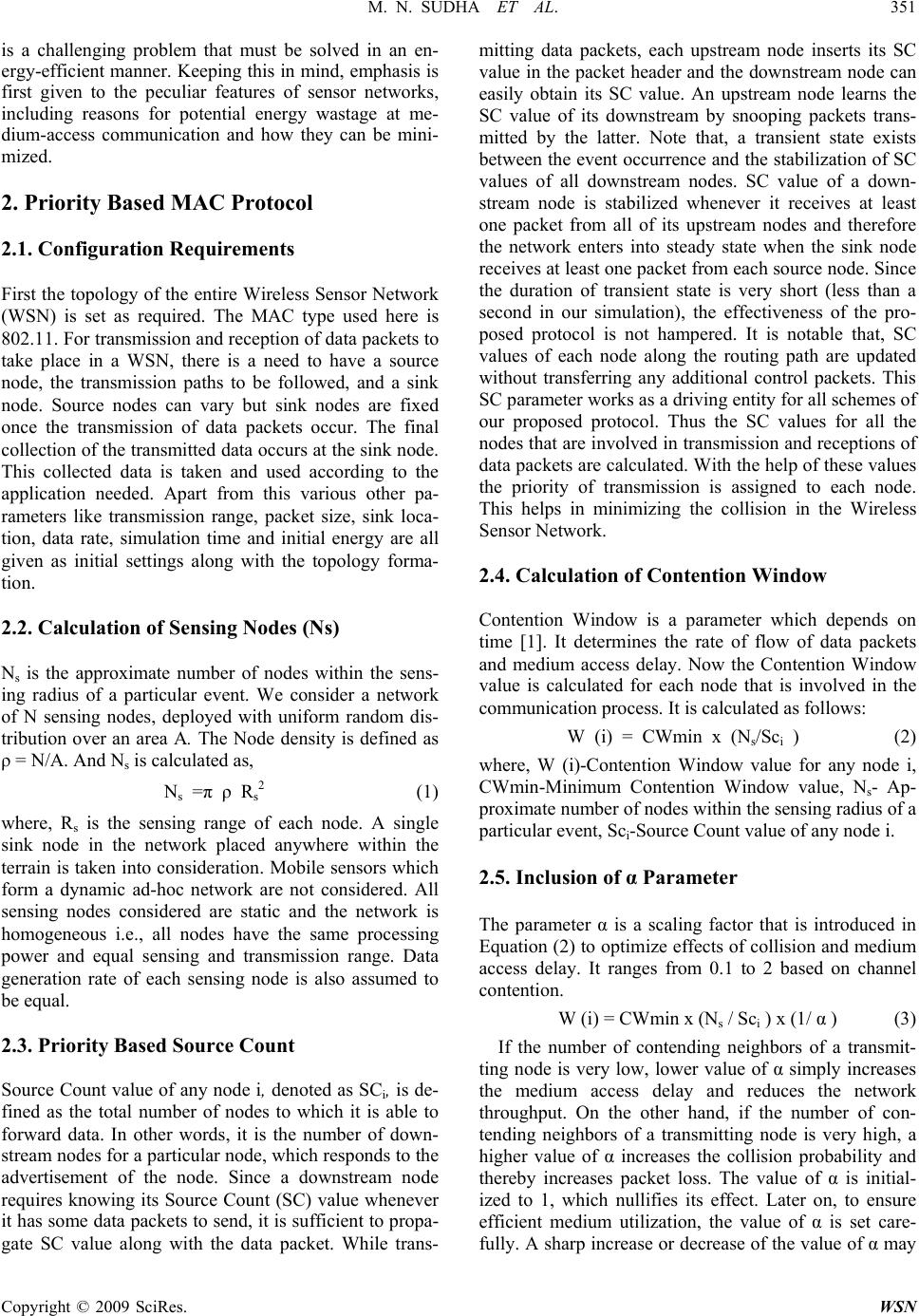
M. N. SUDHA ET AL. 351
is a challenging problem that must be solved in an en-
ergy-efficient manner. Keeping this in mind, emphasis is
first given to the peculiar features of sensor networks,
including reasons for potential energy wastage at me-
dium-access communication and how they can be mini-
mized.
2. Priority Based MAC Protocol
2.1. Configuration Requirements
First the topology of the entire Wireless Sensor Network
(WSN) is set as required. The MAC type used here is
802.11. For transmission and reception of data packets to
take place in a WSN, there is a need to have a source
node, the transmission paths to be followed, and a sink
node. Source nodes can vary but sink nodes are fixed
once the transmission of data packets occur. The final
collection of the transmitted data occurs at the sink node.
This collected data is taken and used according to the
application needed. Apart from this various other pa-
rameters like transmission range, packet size, sink loca-
tion, data rate, simulation time and initial energy are all
given as initial settings along with the topology forma-
tion.
2.2. Calculation of Sensing Nodes (Ns)
Ns is the approximate number of nodes within the sens-
ing radius of a particular event. We consider a network
of N sensing nodes, deployed with uniform random dis-
tribution over an area A. The Node density is defined as
ρ = N/A. And Ns is calculated as,
Ns =π ρ R
s
2 (1)
where, Rs is the sensing range of each node. A single
sink node in the network placed anywhere within the
terrain is taken into consideration. Mobile sensors which
form a dynamic ad-hoc network are not considered. All
sensing nodes considered are static and the network is
homogeneous i.e., all nodes have the same processing
power and equal sensing and transmission range. Data
generation rate of each sensing node is also assumed to
be equal.
2.3. Priority Based Source Count
Source Count value of any node i, denoted as SCi, is de-
fined as the total number of nodes to which it is able to
forward data. In other words, it is the number of down-
stream nodes for a particular node, which responds to the
advertisement of the node. Since a downstream node
requires knowing its Source Count (SC) value whenever
it has some data packets to send, it is sufficient to propa-
gate SC value along with the data packet. While trans-
mitting data packets, each upstream node inserts its SC
value in the packet header and the downstream node can
easily obtain its SC value. An upstream node learns the
SC value of its downstream by snooping packets trans-
mitted by the latter. Note that, a transient state exists
between the event occurrence and the stabilization of SC
values of all downstream nodes. SC value of a down-
stream node is stabilized whenever it receives at least
one packet from all of its upstream nodes and therefore
the network enters into steady state when the sink node
receives at least one packet from each source node. Since
the duration of transient state is very short (less than a
second in our simulation), the effectiveness of the pro-
posed protocol is not hampered. It is notable that, SC
values of each node along the routing path are updated
without transferring any additional control packets. This
SC parameter works as a driving entity for all schemes of
our proposed protocol. Thus the SC values for all the
nodes that are involved in transmission and receptions of
data packets are calculated. With the help of these values
the priority of transmission is assigned to each node.
This helps in minimizing the collision in the Wireless
Sensor Network.
2.4. Calculation of Contention Window
Contention Window is a parameter which depends on
time [1]. It determines the rate of flow of data packets
and medium access delay. Now the Contention Window
value is calculated for each node that is involved in the
communication process. It is calculated as follows:
W (i) = CWmin x (Ns/Sci ) (2)
where, W (i)-Contention Window value for any node i,
CWmin-Minimum Contention Window value, Ns- Ap-
proximate number of nodes within the sensing radius of a
particular event, Sci-Source Count value of any node i.
2.5. Inclusion of α Parameter
The parameter α is a scaling factor that is introduced in
Equation (2) to optimize effects of collision and medium
access delay. It ranges from 0.1 to 2 based on channel
contention.
W (i) = CWmin x (Ns / Sci ) x (1/ α ) (3)
If the number of contending neighbors of a transmit-
ting node is very low, lower value of α simply increases
the medium access delay and reduces the network
throughput. On the other hand, if the number of con-
tending neighbors of a transmitting node is very high, a
higher value of α increases the collision probability and
thereby increases packet loss. The value of α is initial-
ized to 1, which nullifies its effect. Later on, to ensure
efficient medium utilization, the value of α is set care-
fully. A sharp increase or decrease of the value of α may
Copyright © 2009 SciRes. WSN